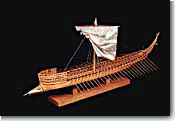

As trade via sea routes began to play a more important role, consequently ship-navigation developed significantly (Theognis, extract 179-180 in West, 1993). During the period 700 -
|
As a result, shipbuilding was forced to adjust to the new reality, but also to correspond to new demands. Information about ships of that period is found in the descriptions of lyric poets, who do not hesitate to adopt the language of Homer's epics. Archilochus and Solon name them tachytata (very fast), Alcaeus mavra (black) (Alcaeus, z 24 in Lobel-Page, Poetarum Lesbiorum Fragmenta, 1955). The first references to ship types such as the pentecontor and the trireme are found: as for the first one in Archilochus, who informs us about the transport of an ambassador to Paros (Archilochus, Tetram. extract 51 in Diehl3), and as for the second one in Hipponax (Hipponax, Iamb.Lib.Inc. extract 45 in Diehl3). |
 |
 |
Warships, the so-called makrai neai (long ships), were used since the |
The pentecontors (fifty-oared ships) were extensively used for transporting goods as well as in war campaigns, mainly by the Phocaeans (Herodotus, Historia 1.163). Their role was very important, precisely because of their ability to sail against the stream and confront enemy ships along dangerous coastlines and passes. They were the fittest for raids, piracy and for transporting goods and troops. They were considered the chief warships before the trireme appeared (Thucydides, Histories 1.14). The Greeks also used the triantacontors, that is ships with 30 oars.
In the
|
| |
|
Note: Click on a picture for a brief description. | |